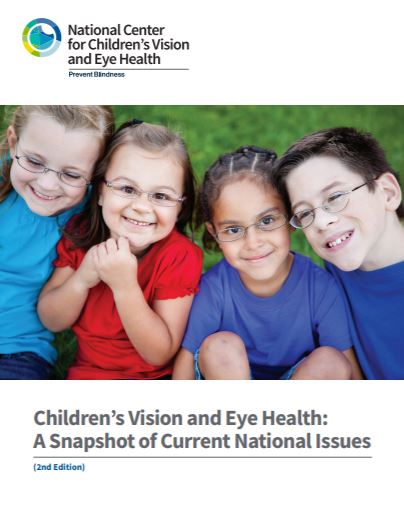“Children’s Vision and Eye Health: A Snapshot of Current National Issues 2nd Edition” Includes Detailed Statistics, Information and Strategies to Improve Children’s Vision in the United States
As part of August’s Children’s Eye Health and Safety Month, and as a follow-up to its 2016 publication, The National Center for Children’s Vision and Eye Health at Prevent Blindness (NCCVEH) has released an updated version of the report titled “Children’s Vision and Eye Health: A Snapshot of Current National Issues 2nd Edition.” The goal of the report is
-
- to provide updated surveillance data,
- share best practices from eye health programs,
- describe current vision screening and eye health requirements for preschool and school aged children for each state in the U.S., and
- share key policies and recommendations from the NCCVEH Advisory Committee on the best approaches to providing children with access to eye care
The Children’s Vision and Eye Health: A Snapshot of Current National Issues 2nd Edition includes an outline and detailed graphics of the national prevalence rates for vision conditions (amblyopia, strabismus, astigmatism, myopia, hyperopia, etc.), including breakdowns by age and ethnic groups. The new report includes expanded sections on early detection of vision disorders, vision screening, special considerations for children with special health care needs, national and federal guidance around children’s vision and eye health, building a comprehensive state vision health program, and new highlights from five states. It also includes revised data on vision testing and the social determinants of health, and a greatly expanded section on equity titled “Equity Matters in Vision.”
The new report also found:
-
- The annual U.S. economic costs of children’s vision disorders total $10 billion.
- Uncorrected refractive errors (including significant near-sightedness, far-sightedness, and astigmatism) in infants and preschool-age children are associated with clinically identified deficits in cognitive and visual-motor functions that may, in turn, have a negative impact on school readiness. Refractive errors make up 70% of decreased visual acuity in Asian and non-Hispanic White children.
- In 2016, 40 states required vision screening for school-age children and only 16 states required vision screening for preschool-age children. In 2020, 40 states mandate some type of vision screening for school-age children and 26 states required vision screening for preschool-age children.
- 39% of all children aged 5 and younger had ever had their vision tested with pictures, shapes or letters and 86% of children aged 6-11 had their vision tested with pictures, shapes or letters within the past 2 years.
- Non-Hispanic children aged 0-17 years whose primary language at home was not English had the lowest percentage of vision testing as compared to children in homes where English or Spanish were spoken.
- Children in families with greater household income are more likely to have received vision testing.
- Children in families with adults that have a college education compared to those in homes with adults that did not complete high school or who have some college education are more likely to have received vision testing.
“The original mission of Prevent Blindness when it was founded back in 1908 was to protect newborns from preventable blinding eye disease,” said Jeff Todd, president and CEO of Prevent Blindness. “More than 110 years later, we continue the mission of protecting children’s vision by promoting evidence-based approaches for ensuring access to the quality eyecare that all children deserve.”
In 2009, Prevent Blindness was awarded a grant from the Maternal and Child Health Bureau at the Health Resources and Services Administration of the U.S. Department of Health and Human Services to establish the NCCVEH. The mission of the NCCVEH is to develop a coordinated public health infrastructure to promote and ensure a comprehensive, multi-tiered continuum of vision care for children. In 2019 alone, the NCCVEH impacted more than 13 million children through improved access to eye care, uniformity in practice and policies, and increased education and awareness of the role of vision in childhood.
The NCCVEH has established a national expert advisory committee from the fields of ophthalmology, optometry, pediatrics, research, school nursing and public health along with family representation. The Advisory Committee assisted in the writing and completion of the report.
In addition to the release of the new report, Prevent Blindness is partnering with the National Optometric Association (NOA) on the new “A.C.H.I.E.V.E: All Children’s Health Initiative for Eye and Vision Excellence” program. The program seeks to raise awareness, specifically among minority parents, for the importance of healthy vision and its connection to learning, as well as encourage parents to have their children’s eyes examined. As part of the A.C.H.I.E.V.E. campaign, free educational webinars will be conducted, and shareable social media images and communications will be available in English and Spanish to promote the importance of healthy vision, especially in minority communities. The materials will be available to download for free at: nationalcenter.preventblindness.org/achieve.
Prevent Blindness partner, OCuSOFT ® Inc., a privately-held eye and skin care company dedicated to innovation in eyelid hygiene and ocular health, will once again make a donation to Prevent Blindness in support of Children’s Eye Health and Safety Awareness Month.
For more information about the Children’s Vision and Eye Health: A Snapshot of Current National Issues 2nd Edition report or children’s vision health topics, please visit https://nationalcenter.preventblindness.org/, or contact Donna Fishman at (800) 331-2020 or [email protected]. For more information on the A.C.H.I.E.V.E program, please visit nationalcenter.preventblindness.org/achieve.
Download a copy of the 2020 Children’s Eye Health and Safety Month release.

